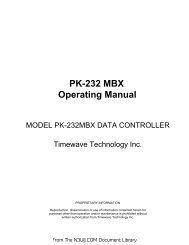DXE-RTR-1 Receive Antenna Interface for Transceivers - N3UJJ
DXE-RTR-1 Receive Antenna Interface for Transceivers - N3UJJ
DXE-RTR-1 Receive Antenna Interface for Transceivers - N3UJJ
- No tags were found...
Create successful ePaper yourself
Turn your PDF publications into a flip-book with our unique Google optimized e-Paper software.
IntroductionThe <strong>DXE</strong>-<strong>RTR</strong>-1 <strong>Receive</strong> <strong>Antenna</strong> <strong>Interface</strong> <strong>for</strong> <strong>Transceivers</strong> is a unique and simple, multi-purposerelay unit which automatically switches the RF output antenna connector on any HF transceiverbetween a receiving antenna system and a standard transmitting antenna. A manual override switchallows instantaneous switching between transmit and receive antennas.Designed specifically <strong>for</strong> HF transceivers which do not have a receive antenna input, the <strong>DXE</strong>-<strong>RTR</strong>-1 enables operators to safely enjoy the improved reception of low noise receiving antennasystem. Connection to Beverages, Reversible Beverages, Active <strong>Receive</strong> <strong>Antenna</strong>s, and otherreceiving antennas and accessories is now possible, only with the <strong>DXE</strong>-<strong>RTR</strong>-1.“An Amateur Radio Dilemma”The benefits of using separate receiving antennas <strong>for</strong> “low-band” HF operations have been known<strong>for</strong> many years. Enthusiasts of operations below 14 MHz have learned that typical transmittingantennas collect too much noise <strong>for</strong> reception, especially <strong>for</strong> DXing on the 160 and 80 meter bands.Un<strong>for</strong>tunately, <strong>for</strong> over three decades, only the most expensive HF transceivers have beenmanufactured with a separate receive antenna input. Even so, many older and newer “high-end”radios do not provide <strong>for</strong> switching their reception between a receive antenna and the defaulttransmit antenna, nor do they interrupt the receive input during transmit. To obtain a separatereceive antenna input, certain models required optional equipment or modules which are no longeravailable.For many Amateur Radio Operators, the joy of low-noise, low-band reception with a separatereceive antenna has been out of reach. Modern, “af<strong>for</strong>dable” HF transceivers have been designedwithout any provision <strong>for</strong> a receive antenna connection. Otherwise very capable transceivers, evenbrand new models, lack a built-in receive antenna port and relay system.The DX Engineering SolutionThe <strong>DXE</strong>-<strong>RTR</strong>-1 <strong>Receive</strong> <strong>Antenna</strong> <strong>Interface</strong> <strong>for</strong> <strong>Transceivers</strong>, offers a special antenna switchingsolution, that incorporates safeguards against accidental RF transmission into a receive antennasystem. The <strong>DXE</strong>-<strong>RTR</strong>-1 may be used <strong>for</strong> switching flexibility and to protect the receiver inputduring transmit <strong>for</strong> those transceivers that are so equipped.Typical homebrew and commercial transmit/receive (T/R) relays, and other receive switchingsolutions on the market, offer little or no protection to the receive antenna equipment. Transmittedenergy could damage receiving equipment if keying and timing errors or power loss occurs.The <strong>DXE</strong>-<strong>RTR</strong>-1 is a new HF relay system that allows reception only if the unit is powered and thekeying line from the transceiver is connected. As soon as the transceiver is keyed or the <strong>DXE</strong>-<strong>RTR</strong>-1 loses power at any time, the RF output from the transceiver is automatically diverted to thetransmit antenna connection. A very fast acting (about 4 ms) 200 watt RF capable relay in the<strong>DXE</strong>-<strong>RTR</strong>-1 diverts the transceiver output quickly enough <strong>for</strong> QSK operation (full break-in CW)3From The <strong>N3UJJ</strong>.COM Document Library
















